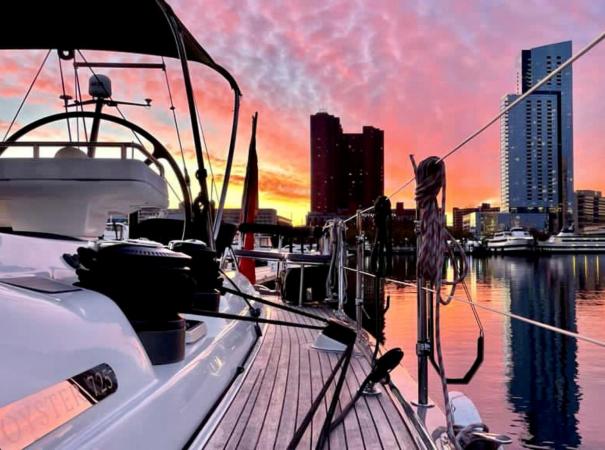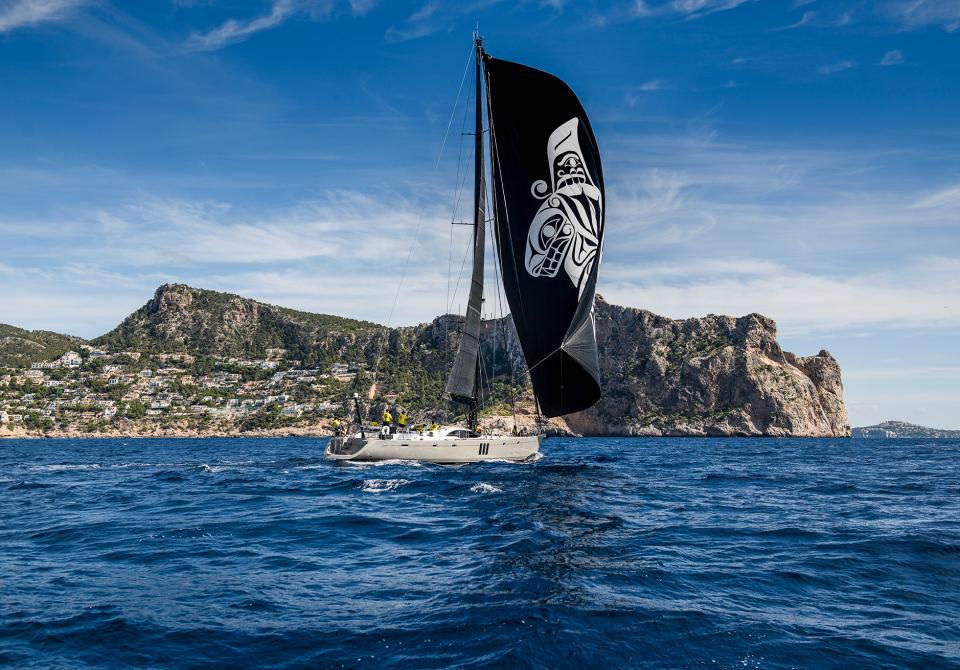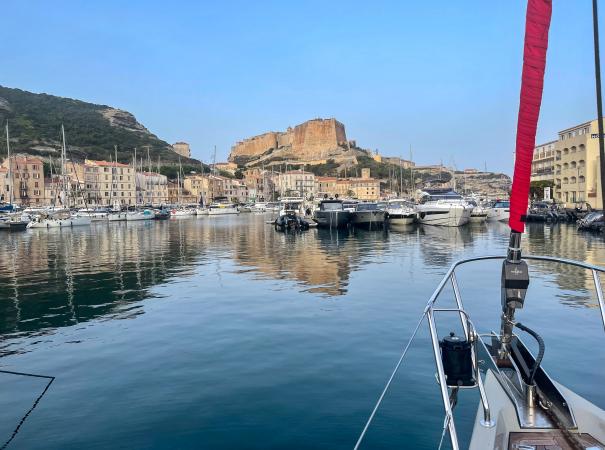The global financial crisis was devastating businesses worldwide and his own water utility companies “had a couple of hundred million dollars of debt. It was very challenging,” he admits, “but those incredible images helped me survive the downturn.“
A decade later, Hill had taken one of his last companies public on the US Stock Exchange and was making those dreams a reality. He had bought Oyster 725/01 Intrepid, had her refitted in Southampton and spent a summer in the Mediterranean before crossing the Atlantic in 2019. Since then, he and his wife Judy, have lived most of the time on board and sailed back to Europe last summer to prepare for the Oyster World Rally 2022-23.
Discover how Trevor and Judy Hill transformed their dream of ocean sailing into reality with an Oyster yacht, overcoming challenges, making upgrades, and embarking on a thrilling adventure.
In a way, the sea was in Trevor Hill’s blood. He grew up in Vancouver and sailed throughout his childhood with his father and brothers. After college, he joined the Royal Canadian Navy as a marine systems engineer and spent many years deployed at sea, ending as deputy engineering officer on a warship during the first Gulf War.
He had been in charge of putting the first reverse osmosis plants on board ships, a nascent technology yet to be used in the sailing world. When Hill retired from the Navy in 1994, he became a serial entrepreneur specialising in water and wastewater treatment. “Then,” he says, “I went in search of more arid climates water reuse in the south-west USA, went to Phoenix in2000 and started a water utility company designed to use less water.
“During all his days in the Navy, Hill had harboured an ambition to go sailing across oceans. “I had done a lot of miles in ships and so I knew it was something I wanted to do,” he explains. In the latter years of running his business, and still with the ambition of owning an Oyster in mind, Hill began tracking all the boats for sale.
“I would read magazines and the more I learned about Oyster Yachts the more I could see that was the right kind of boat for my kind of dream. First of all, they are incredibly beautiful, the aesthetics amazing. But the more I dug in, the more I realised the engineering systems, the thoughtfulness of the design was really important to me. I had been in the engine room for many years and learned all sorts of rules in the Navy and I knew a bit about what it takes to be at sea for a long time, from a capacity and engineering perspective, and from a seaworthiness perspective. What I wanted is to go wherever I wanted and have comfort and safety and range – and do it in style”.
Hill signed up to the Oyster Yachts mailing list and when he read that the company would be running its first round the world rally, Hill says: “That’s when it clicked. It looked fabulous and I told Judy ‘You won’t believe it, but these guys are organising a world rally.’ I watched the rally from the beginning, and it was one of the things that was very attractive about buying an Oyster. It was a huge selling item for us. I thought it was a great idea to have similar boats all of the same brand, for a whole variety of reasons including how capable they are and the similarity of engineering. It made a ton of sense.”
“It was also intriguing that there would be like-minded people coming from different walks of life and countries of origin all with similar issues, experiencing the same adventure at the same time. But I wasn’t ready to go, and we missed the first two rallies and vowed not to miss the third.”
Now very serious about buying a suitable boat, Hill honed in on Oysters. He looked at all the boats for sale and happened to see Intrepid during a business trip to Australia. He arranged to take a look at the boat and decided it would eventually be the ideal yacht for his plans. Hill chartered the boat for two family holidays in Croatia and later the BVIs and when Hill partially retired in 2018, he negotiated to buy her.
“I think a lot of people would say that a 72-footer is a lot of boat for two people,” Hill comments, “but what it boils down to is it’s 70% systems and engineering, and 30% sailing – that is what you end up doing.
“We wanted enough room to have crew if we wished but a boat that we could sail ourselves, and this was the largest boat we felt we could legitimately sail on our own. It is big enough to be luxurious for crew and guests, and it’s a showpiece in that sense, but also rugged enough for any kind of sailing we would want to do.”
The boat was also set up for performance sailing, with a slab reefed mainsail, a carbon rig and carbon sails, and Hill liked that too. “In some ways it makes sailing even more challenging, but I like the purity of that kind of sailing,” he says.
Almost immediately, Hill entered the 2022-23 Oyster World Rally. “I sent my cheque in as soon as I’d bought the boat,” he says. “Our kids were in university and old enough to be on their own and we had a break in the action. I was retired. It was the perfect time."
In late 2018 Intrepid yacht returned to Southampton for a major refit and electronics upgrade to bring the boat back to mint condition.
In spring the following year, the Hills left for the Mediterranean and sailed to Palma and onwards to Greece for the summer. To help learn the boat and the systems, they took on two crew, a captain and mate/chef who had previously worked on Intrepid for five years and knew the boat inside out. Then in Greece, Trevor and Judy both topped up their sailing knowledge with practical courses.
“When our kids were young, we would charter as family, and we had gained experience through doing that. Last year Judy did her Day Skipper ticket, and we had hired the crew to train us and work with us for six months as I got my Yachtmaster and Ocean Yachtmaster tickets, including [learning] docking and mooring, and all the systems – every aspect so that we could take whatever skills we had and put it all together,” says Trevor.
This proved to be an extremely sensible approach to learning exactly what is required to live on board and run a complex yacht and gain confidence. “I have the background in engineering, but with all these boats you can’t think of them like a car, it is not a fire-and-forget solution. There is a level of detail anyone is going to have to chin themselves up to,” comments Hill.
“We knew that when you take on a boat like this it is a significant undertaking. I think of it like climbing Everest or any other extreme adventure: there is a ticket price to be on the ride, and that is becoming incredibly familiar with the systems and spaces and mastering that. So, when things break, that is part of the opportunity and I remind myself and put a smile on my face. When it is just the two of us, it is nearly a full-time job.”
I sent my cheque in as soon as I’d bought the boat. Our kids were in university and old enough to be on their own and we had a break in the action. I was retired. It was the perfect time.
In late 2019 the Hills departed the Mediterranean for the Canary Islands to join the ARC transatlantic rally to St Lucia. Again, they took on three professional crew for the crossing but once in the Caribbean the crew disembarked, and the Hills were on their own. They sailed south to Grenada then charted a course all the way through the Windward Islands to St Maarten.
They had left Intrepid there in March 2020 while they made a short trip home to the US, when COVID arrived and most of the world locked down. Intrepid stayed in the marina in St Maarten for 100 days until the Hills finally got a chance to return to her in late June. But the fall-out meant their plan to return across the Atlantic and sail to Norway had to be shelved and instead the Hills took on a new temporary crew and sailed the boat to Portland, Maine, where they arrived in July.
One of the crew, whom they had hired through the Oyster Crew service, “turned out to be a great sailor and a great guy, and we kept him on for six months and sailed all the way to the Canadian border,” says Hill. “Then we sailed all the way back south to Cape Cod and Newport, down to New York City in October and to Chesapeake, Annapolis and Charleston in November.” While in Savannah, the Hills did a mini refit on their boat before sailing onwards to West Palm Beach in Florida in time for Christmas.
As 2021 began, the Hills were on their own on board again, just the two of them. They set off southbound on the route known as the Thorny Path, the windward passage between Florida and St Maarten. Between January and April, they cruised to the Bahamas and Exumas, the Turks and Caicos, the Dominican Republic, Puerto Rico and then through the Spanish, US and Spanish Virgin Islands. “There were a lot of shorter night passages. It was very, very challenging but rewarding and an unusual period. Some of those places are very fancy and others are still developing,” Hill recalls.
It was during this period that the Hills truly began to feel at one with their boat. “I think in a sense it took that long,” says Hill. “The day you close on a boat you don’t have that feeling right away. You kind of have to earn it and I didn’t really anticipate how long it would take. You have to make the boat your own and run the boat and sail it. The first time I felt that was in the Caribbean after we had owned it for a year. It was just the two of us sailing among those incredible islands and coming up to anchor off some sandy tropical beach and plunging into the ocean. The more comfortable we became, the more we have spread our wings.”
From the Caribbean in 2021, the Hills made their way back to the Mediterranean via the Azores with a new level of confidence. Hill remembers making landfall in the Azores as one of the most satisfying and memorable moments of all their voyaging so far. “It was my first Atlantic crossing as a captain, and to arrive safely in the Azores, where all the planning and organisation came together, was an incredible feeling.
After returning to the Mediterranean, the Hills spent time cruising in the Balearics, France and Italy before heading for Palma, Mallorca, to have work done on Intrepid in preparation for their circumnavigation.
Among the jobs list were some enhancements including new instrumentation, a new anchor and ground tackle, a carbon bowsprit and asymmetric spinnaker on a top-down furler, and a total rebuild of the power systems to increase Intrepid’s range, self-sufficiency and comfort. An array of lithium ion batteries were fitted, plus new chargers and inverters.
The most visible change is a custom-designed carbon fibre hard-top bimini fitted with solar panels. This not only gives the crew shelter from the sun, the solar power generated has considerably increased periods of silent running and decreased reliance on diesel. “Intrepid looks and feels like a new boat and is in all respects ready for the next 50,000 miles of sailing she’ll see over the next two to three years,” Hill comments. Meanwhile, the couple recruited two professional crew, a mate and chef, to join nine months before the rally and gain an intimate knowledge of the boat and learn how Trevor and Judy Hill prefer to run Intrepid and live on board.
“The Oyster World Rally is a significant undertaking with a lot of complexity,” Hill explains. “We didn’t want to be maintaining the boat in every harbour along the way. There is so much passage making and I like to get off the boat for a bit and have that freedom.
Choosing crew was one of their biggest decisions, as they are looking for harmonious partners to participate in this once-in-a-lifetime voyage rather than staff to provide a service. “We see our crew as partners with us and always expressed it in that way, we are not looking for service per se. You are living in relatively close quarters and we were looking for people who really wanted to share in the adventure.”
In early November, with winter beginning to bite, the Hills left Palma and flew out of the Strait of Gibraltar and into the Atlantic on the heels of a 50-knot Mistral. With their boat running smoothly, the watch systems falling into a rhythm and the boat “brimming” with good provisions “and 10 cases of Spain’s best wine carefully stowed”, the Hills headed south and west to Madeira and the Canary Islands.
Ahead of them lies some 30,000 miles of tropical sailing, their third crossing of the Atlantic in three years and, beyond that, long passages through the archipelagos of the South Pacific. Although focussed on the circumnavigation ahead, Hill nevertheless admits that a part of his mind is already dreaming of other, future voyages of exploration.
“It was when we arrived in the Azores after my first crossing as captain that we thought: we really can do this. We are organised enough to do anything. We started thinking: I wonder if we should do Patagonia? I wonder if we should sail to Antarctica, or the Northwest Passage? You start to think there is no limit,” he says.
“In a way it’s what these Oysters do to you. They open your eyes to the incredible world of possibilities. And you don’t have to talk about it very long before you find someone in the Oyster family that has already done those things and you have a wealth of information at your fingertips.”
Intrepid looks and feels like a new boat and is in all respects ready for the next 50,000 miles of sailing she’ll see over the next two to three years









